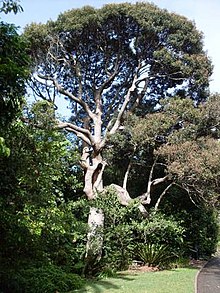
Cryptocarya obovata

| Cryptocarya obovata | |
|---|---|

| |
| At the Royal Botanic Garden, Sydney | |
| Scientific classification | |
| Kingdom: | Plantae |
| Clade: | Tracheophytes |
| Clade: | Angiosperms |
| Clade: | Magnoliids |
| Order: | Laurales |
| Family: | Lauraceae |
| Genus: | Cryptocarya |
| Species: | C. obovata
|
| Binomial name | |
| Cryptocarya obovata | |
Cryptocarya obovata, commonly known as pepperberry, white walnut, long tom, she beech or purple laurel,[2] is a species of flowering plant in the laurel family and is endemic to eastern Australia. It is a rainforest tree with oblong to egg-shaped leaves, the flowers creamy-green, tube-shaped and unpleasantly perfumed, and the fruit a spherical drupe with white or cream-coloured cotyledons.

Description
Cryptocarya obovata is a tree that typically grows to a height of up to 40 m (130 ft) with a dbh of 90 cm (35 in), its stems sometimes buttressed. The leaves are oblong to egg-shaped with the narrower end towards the base, 50–105 mm (2.0–4.1 in) long, 20–40 mm (0.79–1.57 in) wide and usually glaucous. The hairy underside of the leaves gives the tree a rusty appearance when viewed from below. The leaf veins are brownish-orange or yellow and prominent with the midrib and lateral veins covered with brown hairs.[2][3][4]

The flowers are creamy-green and unpleasantly perfumed, arranged in panicles shorter than the leaves. The perianth tube is 1.0–1.6 mm (0.039–0.063 in) long and 1.4–1.7 mm (0.055–0.067 in) wide and softly-hairy on the inside. The outer tepals are 1.8–2.0 mm (0.071–0.079 in) long and 0.9–1.3 mm (0.035–0.051 in) wide, the inner tepals 1.7–2.0 mm (0.067–0.079 in) long and 1.2–1.5 mm (0.047–0.059 in) wide. The ovary is 1.0–1.1 mm (0.039–0.043 in) long and 0.4–0.5 mm (0.016–0.020 in) wide and usually covered with soft hairs. Flowering occurs from January to May, and the fruit is a spherical black drupe, about 12 mm (0.47 in) long and 11–13 mm (0.43–0.51 in) wide, with white or cream-coloured cotyledons.[2][3][4]

Taxonomy
Cryptocarya obovata was first formally described in 1810 by Robert Brown in his book, Prodromus Florae Novae Hollandiae.[5][6] The specific epithet (obovata) means 'inverted egg-shape'.[7]

Distribution and habitat
Pepperberry grows on basaltic and fertile alluvial soils in rainforests from Wyong in New South Wales to Gympie in Queensland. It is extinct in the Illawarra region of New South Wales, and was allegedly last seen in the Illawarra in 1818 by Allan Cunningham.[8]

Ecology
Fruit ripen from March to May, and are eaten by Australasian figbird, rose-crowned fruit-dove, topknot pigeon and wompoo fruit dove.

Gallery
-
Botanical drawing by Margaret Flockton
-
Cryptocarya obovata at the Royal Botanic Gardens, Sydney
-
Bark
-
Juvenile
-
Leaves showing venation
References
- ^ "Cryptocarya obovata". Australian Plant Census. Retrieved 23 September 2024.
- ^ a b c Le Cussan, J.; Hyland, Bernard P.M. "Cryptocarya obovata". Flora of Australia. Australian Biological Resources Study, Department of Climate Change, Energy, the Environment and Water: Canberra. Retrieved 23 September 2024.
- ^ a b Floyd, A.G. (1989). Rainforest Trees of Mainland South-eastern Australia. Inkata Press. ISBN 0-909605-57-2.
- ^ a b Harden, Gwen J. "Cryptocarya obovata". Royal Botanic Garden Sydney. Retrieved 23 September 2024.
- ^ "Cryptocarya obovata". APNI. Retrieved 23 September 2024.
- ^ Brown, Robert (1810). Prodromus florae Novae Hollandiae et Insulae Van-Diemen, exhibens characteres plantarum. London: typis R. Taylor et socii. p. 402. Retrieved 23 September 2024.
- ^ George, Alex; Sharr, Francis (2021). Western Australian Plant Names and Their Meanings (4th ed.). Kardinya, WA: Four Gables Press. p. 263. ISBN 9780958034180.
- ^ Bofeldt, Anders (2011). "Table 1: Cryptocarya obovata" (PDF). Plants at Risk in the Illawarra: Introduction to Table 1 (PDF) (Technical report). Online via LandcareIllawarra.org.au. NSW. Retrieved 25 Apr 2013.<name=Landcare>"Tribute to Anders". Landcare Illawarra. Archived from the original on 2012-07-19.
External links
- "Cryptocarya obovata R.Br". Atlas of Living Australia.
See what we do next...
OR
By submitting your email or phone number, you're giving mschf permission to send you email and/or recurring marketing texts. Data rates may apply. Text stop to cancel, help for help.
Success: You're subscribed now !





